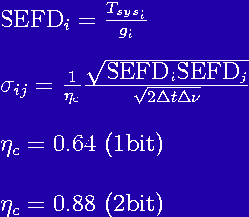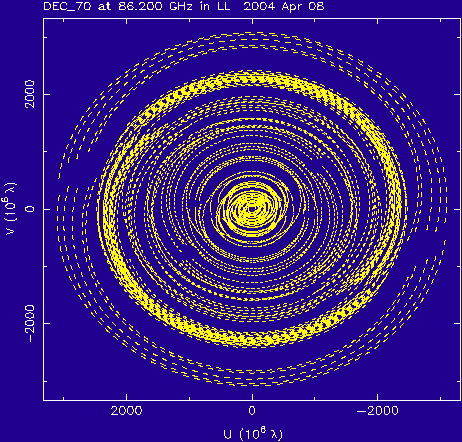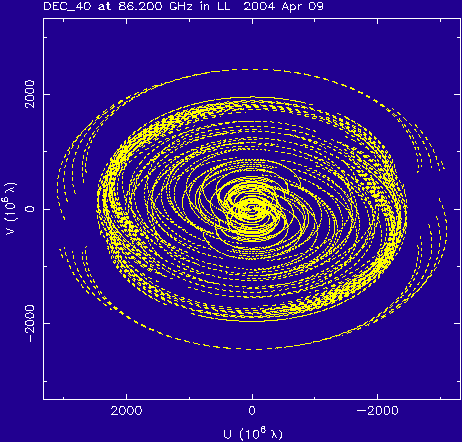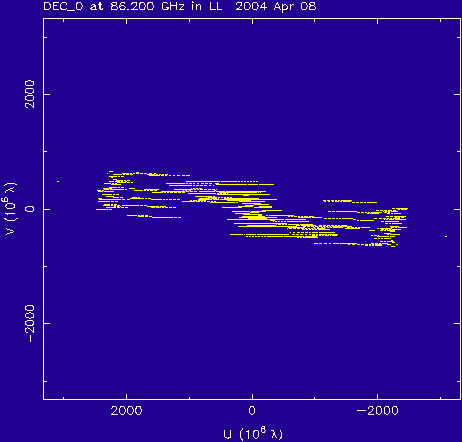Sensitivities
A. 3mm VLBI detection limits
Here we assume optimum weather conditions (low opacity, tau < 0.1, no clouds).
Important: Depending on weather and elevation, Tsys and SEFD could be considerably higher!
Antenna and Receiver properties at 86 GHz:
| Station | Diameter (m) | Tsys (K) | Gain (K/Jy) | Eta (%) | SEFD (Jy) | Comment |
|---|---|---|---|---|---|---|
| GBT | 100.0 | 130.0 | 0.98 | 35 | 133 | for nighttime observing |
| Effelsberg | 80.0 (eff.) |
140.0 | 0.14 | 7.7 | 1000 | - |
| Noema | 46.2 (eff.) | 70.0 | 0.42 | 70 | 163 | 10x15m |
| Pico Veleta | 30.0 | 100.0 | 0.15 | 60 | 654 | - |
| Yebes | 40.0 | 100.0 | 0.10 | 22 | 990 | - |
| VLBA (8x25m) | 25.0 | 115.0 | 0.028 | 16 | 4100 | range is: 0.01-0.04 K/Jy |
| KVN (3x21m) | 21.0 | 150.0 | 0.05 | 40 | 3000 | for each 21m antenna |
| Onsala | 20.0 | 130.0 | 0.049 | 43 | 2650 | - |
| Metsähovi | 14.0 | 150.0 | 0.010 | 18 | 15000 | - |
| LMT (prelim) | 50 | 200.0 | 0.39 | 55 | 513 | double side band |
| GLT | 12 | 170 | 0.032 | 78 | 5312 | - |
| ALMA | 71.1 (eff.) | 70.0 | 1.02 | 71 | 69 | 37x12m |
7 sigma single baseline detection thresholds (all numbers in mJy):
link to: EVN Sensitivity calculator1 (classic, please open in new browser window), and EVN Sensitivity calculator2 (new), and GMVA Sensitivity Calculator
| - | Noema | Pico Veleta | Yebes | Onsala | Metsähovi | VLBA | GBT | KVN | LMT | ALMA37 |
|---|---|---|---|---|---|---|---|---|---|---|
| Effelsberg | 32 |
64 |
78 |
128 |
304 |
150-290 |
29 |
136 |
56 |
21 |
| Noema | - | 26 |
32 |
52 |
124 |
60-120 |
12 |
56 |
23 |
8 |
| Pico Veleta | - | - | 63 |
104 |
246 |
120-230 |
23 |
110 |
46 |
17 |
| Yebes | - | - | - | 127 | 303 |
150-289 |
29 |
136 |
56 |
21 |
| Onsala | - | - | - | - | 496 |
245-470 |
47 |
222 |
92 |
34 |
| Metsähovi | - | - | - | - | - |
580-1120 |
111 |
527 |
218 |
80 |
| VLBA | - | - | - | - | - |
287-1047 |
55-106 |
259-503 |
107-208 |
39-76 |
| GBT | - | - | - | - | - |
- |
- |
50 |
21 |
8 |
| KVN | - | - | - | - | - |
- |
- |
- |
98 |
36 |
| LMT | - | - | - | - | - |
- |
- |
- |
- |
15 |
| Baseline Sensitivity: | to Effelsberg: 20-300 mJy |
| to Noema: 8-125 mJy | |
| to GBT: 8-111 mJy | |
| to ALMA: 8-80 mJy | |
| | |
| Array Sensitivity (1 sigma): | 0.087 mJy/hr (Europe+VLBA) |
| 0.052 mJy/hr (Europe+VLBA+GBT) | |
| 0.029 mJy/hr (Europe+VLBA+GBT+ALMA) | |
| These numbers have to be increased by a factor of exp(tau*A) , i.e. for tau=0.1 and airmass A= 1/sin (elv) = 2, the factor is 1.22 | |
| Depending on weather, the phase stability and atmospheric coherence time can vary between 10-180 seconds. | |
| Important Note: Because of antenna pointing, calibration and phasing of ALMA/NOEMA the typical VLBI duty cycle is 0.5. This means that for 1 hour of on source VLBI time, 2 hours of real observing are required. |
| Assuming the following observing parameters: |
|
|
MK6, 4096-16-2 (DDC), single polarisation |
|
|
512 MHz per polarisation |
|
|
10.0 sec (typical coherence time) |
|
|
7.*sigma |
|
|
2 Bit |
Useful formulae:  |
|
B. Simulated uv-coverage for the Global 3mm-VLBI Array
1. uv-plot of a source with a declination of 70 degree 2. uv-plot of a source with a declination of 40 degree 3. uv-plot of a source with a declination of 0 degree |
||||